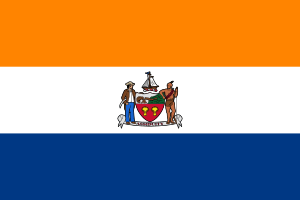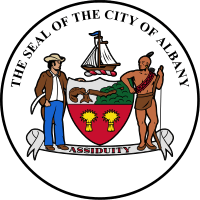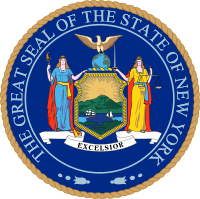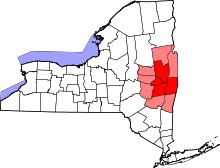Port of Albany–Rensselaer
| Albany–Rensselaer | |||
| Albany | |||
| Port
| |||
|
|||
| Official name: Port of Albany–Rensselaer | |||
| Named for: the two cities in which the port is sited | |||
| Motto: Gateway to the Northeast[1]
Our ships just keep coming in![2] | |||
| Country | United States | ||
|---|---|---|---|
| State | New York | ||
| Counties | Albany and Rensselaer | ||
| Cities | Albany and Rensselaer | ||
| Location | Hudson River | ||
| - coordinates | 42°37′41″N 73°45′27″W / 42.62806°N 73.75750°WCoordinates: 42°37′41″N 73°45′27″W / 42.62806°N 73.75750°W | ||
| Founded | 1932 | ||
| Management | Albany–Rensselaer Port District | ||
| District Chairman | Robert F. Cross | ||
| - Treasurer | Anthony J. Ferrara | ||
| - Manager | Richard Hendrick | ||
| Timezone | EST (UTC−5) | ||
| - summer (DST) | EDT (UTC−4) | ||
| ZIP code | 12202 | ||
| Area code | +1 518 | ||
| Annual Tonnage | 7,540,535 (2004) | ||
 Location of Albany in New York | |||
| Wikimedia Commons: Port of Albany-Rensselaer | |||
| Website: http://www.portofalbany.com | |||
The Port of Albany–Rensselaer, widely known as the Port of Albany, is a port of entry in the United States with facilities on both sides of the Hudson River in Albany and Rensselaer, New York. Private and public port facilities have existed in both cities since the 17th century, with an increase in shipping after the Albany Basin and Erie Canal were built with public funds in 1825.
The port's modern name did not come into widespread use until 1925; the current port was constructed in 1932 under the governorship of Franklin D. Roosevelt during the Great Depression. It included the largest grain elevator in the world at the time. Today the grain elevator is the largest in the United States east of the Mississippi River; the port has the tallest harbor crane in the state of New York.
The port has rail connections with the Albany Port Railroad, which allows for connections with CSXT and CP Rail. It is near several interstates and the New York State Canal System. The port features several tourist attractions as well, such as the USS Slater (DE-766), the only destroyer escort still afloat in the United States.
Geography
The Port of Albany consists of roughly 236 acres (96 ha), including about 202 acres (82 ha) in Albany and 34 acres (14 ha) in Rensselaer. It is 124 nautical miles (230 km) north of New York Harbor.[3] From New York Harbor to the Federal Dam three miles (5 km) north of Albany, the Hudson River is an estuary of the Atlantic Ocean.[4] The Hudson has a deep water shipping channel 400 feet (120 m) across, and at Albany the river is 700 feet (210 m) across with a maximum 31 feet (9.4 m) saltwater draft and a mean range of tides of 4.7 feet (1.4 m).[1] The port is at sea level.
History

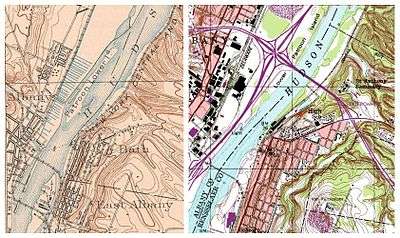

Since the founding of Albany in 1624 as a trading post,[5] shipping has been important to its growth and prosperity. Furs (especially beaver), timber, and farm produce were important exports while European people and goods were shipped in. The Dongan Charter, which established Albany as a city, made Albany the exclusive market town in the upper Hudson River Valley. From its beginning, the port consisted of hastily built docks built every spring and destroyed every winter by erosion, flooding, ice, and tidal action.[6] Three city-owned docks were established in 1766,[7] the northern and southern ones later being expanded into wharves.
Many historically significant ships used Albany as their home port. The Experiment left Albany in 1785 to become the second American ship to sail to China.[8] In 1809 Robert Fulton's Clermont became the first commercially viable steamboat when it left Albany and sailed down the Hudson to the city of New York. In 1825 a 4,300-foot (1,300 m) long and 80-foot (24 m) wide pier was constructed 250 feet (76 m) from, and perpendicular to, Albany's shoreline.[9] Along with two bridges the pier enclosed roughly 32 acres (13 ha) of the Hudson River as the Albany Basin. The construction of the pier and bridges cost $119,980.[10] The basin was located where the Erie Canal, constructed between 1818 and 1825, met the Hudson River. The basin could accommodate 1,000 canal boats and 50 steamboat moorings.[9] Along the Erie Canal within the city's North Albany neighborhood private wharves and slips were constructed for use in the lumber trade, this soon became the large and prosperous Albany Lumber District of national importance. In 1860 Albany, along with nearby Watervliet and Troy, was the largest lumber market in the state.[11] The Maiden Lane Bridge was constructed in 1871 over the basin to connect Albany with the east side of the river, it was open to railroad traffic only.
The Albany Port District was established in 1925 under New York law Chapter 192.[12] This was only four years after the interstate compact that created the Port of New York Authority (later renamed the Port Authority of New York and New Jersey). In 1932 Governor Franklin D. Roosevelt unveiled a modern port to replace the aging infrastructure of the Albany Basin and the lumber district along the Erie Canal in the North Albany neighborhood.[13] The port was constructed on around 200 acres (0.81 km2) on Westerlo Island in the southern end of Albany along with approximately 34 acres (140,000 m2) across the river in the city of Rensselaer. The grain elevator at the port, built during the original construction in 1932, was the largest in the world and as of 2008 is still considered to be the largest in the United States east of the Mississippi River.[14] The area of Albany's original port (the Albany Basin) has been covered by Interstate 787 and the Corning Preserve (Riverfront Park) since the very early 1970s.[15] In 1979 remnants of the basin wall were excavated from the preserve's lagoon by Phillip Lord working for the New York State Museum.[16]
A Master Plan adopted in 2000 called for the port to be transformed into a container port,[17] which led to the purchase of the largest harbor crane in the state. In 2002, the Port District Commission took the lead in the development of Albany's Riverfront Park in the Corning Preserve as part of a development to enhance Albany's access to the river. The port helped in financing the project and in the construction of two bulkheads which have seasonal floating docks attached.[18] In a 2005 audit, the Office of the State Comptroller questioned the port's involvement in the construction and financing. Two issues raised were the port district's lack of authority to build docks for non-commercial use and that the port would receive no income for facilities it was financing.[17] The port received $3.3 million in 2002 to upgrade and become a member of the Inland Distribution Network, a select group of ports that are used as satellite locations for the distribution of container cargo from the Port Authority of New York and New Jersey, resulting in less congestion at downstate ports and highways.[19]

On December 9, 2003, the Stellamare, a Dutch-owned ship, capsized at the port, killing three Russian crewmembers. The ship was hauling General Electric generators when it overturned. The United States Coast Guard determined that poor communication resulting from the supervisors speaking Dutch while the crew spoke Russian, with English being used as a relay, was a contributing factor to mismanagement of ballast tanks.[20] In the early spring of 2008 a port employee was arrested for stealing copper.[21] This in turn led to investigations of employee theft which resulted in the arrest of an operations manager and a maintenance foreman for larceny.[22] In 2008 the port received two awards from the Railway Industrial Clearance Association. One award was for customer satisfaction and the other for being the most improved port in the United States for handling heavy lift cargo.[23]
Future
The Port of Albany is replacing 500 feet (150 m) of wharvage at a cost of $7.6 million in 2008 and 2009.[24] In late March 2008 a proposal for a $350 million ethanol plant was approved by the Albany Port District Commission,[25] but the project has been held up due to financing issues.
Governance
The Albany Port District Commission is a public benefit corporation created by the state of New York to develop and manage port facilities anywhere in the cities of Albany and Rensselaer. The commission has five members, four of which are nominated by the mayor of Albany and one is nominated by the mayor of Rensselaer. The governor of New York then appoints them to three-year terms.[12] The commissioners serve without pay, but are compensated for business related expenses.[17] The commission is considered to be a unit of the city of Albany and is included in the city's financial statements. Any deficit in the finances of the commission are assessed against both Albany and Rensselaer. In 1932 the state decided that any deficit assessment would be based on Albany owing 88% of the total and Rensselaer 12%.[2] In 2005 the commission had a staff of 35 employees: eight in administrative duties, five in maintenance, and 22 as part-time security.[17]
Economy
The Port of Albany and the private companies located there bring to the Capital District's economy $428 million in direct spending and 1,382 jobs.[24] The port has a U.S. Customs office as it is a port of entry. The Albany Port Customs District includes all of the following counties: Albany, Columbia, Delaware, Fulton, Greene, Montgomery, Otsego, Rensselaer, Saratoga, Schenectady, Schoharie, Warren, and Washington; along with the parts of Dutchess, Sullivan, and Ulster counties north of 41° 42' N. latitude. The 35 acres (140,000 m2) on the Rensselaer side of the port is site C of Foreign Trade Zone number 121.[26] A significant amount of the port is part of New York's Empire Zone program,[27] which gives port tenants breaks on state income tax along with various benefits and tax breaks from the city of Albany.
Connections
The Port of Albany is roughly 260 miles (420 km) east of Buffalo, 225 miles (362 km) south of Montreal, 175 miles (282 km) west of Boston, and 135 miles (217 km) north of the city of New York which makes it a location for regional distribution in the Northeastern United States and parts of Canada. As part of the Inland Distribution Network, the Port of Albany has a twice-weekly barge service to and from the Port Authority of New York and New Jersey terminals. Shipments into the port can leave through many modes of transportation, including by truck and rail. Albany International Airport is 15 minutes away with cargo facilities. Canals allow for further water transportation on barges further into the interior of North America. The port also handles commodities that are not carried on ships. Grain, molasses, animal feed, wood pulp, and steel often go from inbound trains to outbound trucks.[28]
Rail
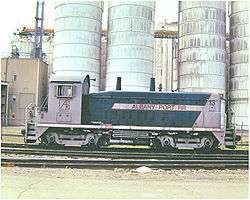
The Albany Port Railroad (APRR), owned jointly by CSX and Canadian Pacific Railway (CP Rail), has 18 miles (29 km) of track inside the port.[29] The APRR ties into CP Rail's Colonie Mainline and CSX's Port Subdivision for rail traffic out of the port.[28] Norfolk Southern has an intermodal yard at the port.[30] CP Rail's Kenwood Yard is adjacent to the port. The North Albany–Erie Street Yard, also owned by CP Rail, is a few miles north of the port and still in the city of Albany. CSX owns two nearby yards: the Selkirk Yard is eight miles (13 km) south of the port, and the West Albany Yard is four miles (6 km) north.
Truck
Major Interstates in proximity are:
 New York State Thruway, a toll-road (west from Albany it is Interstate 90 to Buffalo and beyond; south the Thruway is Interstate 87 to the New York Metro Area);
New York State Thruway, a toll-road (west from Albany it is Interstate 90 to Buffalo and beyond; south the Thruway is Interstate 87 to the New York Metro Area); I-787 connects Albany to Troy, New York;
I-787 connects Albany to Troy, New York; I-87 (south of Albany it is the Thruway, to the north the Adirondack Northway then at the Canada–US border it becomes Autoroute 15 to Montreal);
I-87 (south of Albany it is the Thruway, to the north the Adirondack Northway then at the Canada–US border it becomes Autoroute 15 to Montreal); I-90 (west of Albany it is the Thruway, to the east toll-free until rejoining the Thruway on its Berkshire Spur and continuing to Boston as the Mass Turnpike);
I-90 (west of Albany it is the Thruway, to the east toll-free until rejoining the Thruway on its Berkshire Spur and continuing to Boston as the Mass Turnpike); I-88 connects Albany to Binghamton, New York.
I-88 connects Albany to Binghamton, New York.
Water-to-water
The Port of Albany is just south of where the New York State Canal System begins at the Federal Dam in Troy. The Erie Canal allows for water navigation to the Great Lakes, and the Champlain Canal connects the Hudson River to Lake Champlain. The Richelieu River/Chambly Canal then connects Lake Champlain to the St. Lawrence Seaway and Montreal.
Facilities
The Port of Albany includes:
- Deep water facilities located on both banks of the river;[3]
- two wharves: wharf length on the Albany side of the river is 4,200 feet (1,300 m) with four berths, and on the Rensselaer side the length is 1,100 feet (340 m) with one berth;
- 10-acre (4.0 ha) open storage yard;[3]
- Customs and U.S. Department of Agriculture offices;[3]
- Five transit sheds and two backup warehouses totaling 350,000 square feet (33,000 m2) of storage; [3]
- 13,500,000 US bushels (480,000,000 l; 108,000,000 US dry gal; 105,000,000 imp gal) capacity grain elevator;[3]
- 18-million-US-gallon (68,000 m3) capacity bulk liquid storage between two terminals; [3]
- Heavy lift on-dock rail capability;[3]
- Super-sacking and debagging operation;[3]
- 12-acre (4.9 ha) road salt depot;[3]
- 12-acre (4.9 ha) scrap yard;[3]
- a 225-short-ton (201-long-ton; 204-metric-ton) capacity crane and a mobile harbor crane,[3] which is the largest harbor crane in the state of New York.[2][28]
Maritime services
Stevedoring operations at the Port of Albany are managed by Federal Marine Terminals, Inc.[31] and Port Albany Ventures, LLC.[32] The Hudson River Pilots Association handles pilotage on the Hudson River.[1]
Tenants
The rent from the 32 businesses at the port contributes $2.76 million in revenue for the port.[33] Tenants include Global Partners LP which has a petroleum distillates terminal with a capacity of 738,000 barrels (117,300 m3).
Cargo
Some commodities come through the port on a regular basis, others are special cargo for a limited time. Such limited time cargo includes subway cars shipped to Albany from Brazil in 2006 for six months,[34] and 30-inch (760 mm) diameter pipes with associated materials from Italy first shipped in May 2007. The pipes were for a 186-mile (299 km) long natural gas pipeline and included 60,000 short tons (53,571 long tons; 54,431 t) of material in about a dozen ships.[2] Commodities shipped to or from Albany on a regular basis include:
- Animal feed;[28]
- Cement;[2]
- Cocoa beans;[35]
- Grain (including corn and wheat);[14]
- Gypsum;[35]
- Ethanol;[14]
- Heavy lift items (including turbines, generators, heat exchangers, and rotors);[35]
- Liquid fertilizer;[2]
- Millscale and scrap metal;[35]
- Molasses;[2]
- Petroleum distillates (including diesel, gasoline, heating oil, and kerosene);
- Salt;[35]
- Steel;[33]
- Sugar;[34]
- Wood pulp and logs.[35]
Tourism
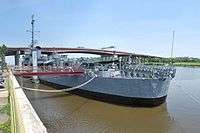
Along with commercial activities the Port of Albany has non-industrial uses along the river. A ship museum and a tourism cruise ship are docked at the Steamboat Square. Steamboat Square was, until 2010, named the Snow Dock for being where city trucks dumped into the Hudson River snow plowed from the streets.[36] A PortFest was held in 2007 to commemorate the 75th anniversary of the Port of Albany-Rennselaer and the 10th anniversary of the USS Slater as a museum docked at Albany.[37] National Maritime Day is celebrated with free trolley rides of the port and free rides aboard the Dutch Apple Cruise.[36]
The USS Slater (DE-766), which is the only destroyer escort still afloat in the United States, sits at Steamboat Square near the foot of Madison Avenue.[38] The ship is open from April to November to the public. The destroyer closes to the public from December to March and moves from the Steamboat Square to the port's Rensselaer side.[38] In August 2008 part of the Japanese film Orion in Midsummer (scheduled for release in spring 2009) was filmed on board.[39]
Dutch Apple Cruises, a private company which gives day cruises on the Hudson River and Erie Canal, also operates at the Steamboat Square.[40] The city of Albany has a public boat launch and boat house along the Hudson in the Corning Preserve. The boat house and launch are used by the Albany Rowing Center, a non-profit rowing organization.[41] On the Rensselaer side of the Hudson is the Albany Yacht Club. The club was founded in the city of Albany in 1873 and is one of the oldest yacht clubs in the nation. In 1954 the club moved to the Rensselaer side and since 1971 has been at its current location just south of the Dunn Memorial Bridge. Facilities are open to the public at large and not just to members.[42]
See also
- Capital District
- History of Albany, New York
- List of North American ports
- List of ports in the United States
References
- 1 2 3 "Transportation Hub". Albany Port District. Retrieved 2010-10-26.
- 1 2 3 4 5 6 7 "Port of Albany Annual Report 2009" (PDF). Albany Port District Commission. Retrieved 2010-10-26.
- 1 2 3 4 5 6 7 8 9 10 11 12 "Port facilities.". Albany Port District. Retrieved 2008-11-30.
- ↑ Jeffrey S. Levinton. "The Hudson River Estuary: The Basics". State University of New York at Stony Brook. Retrieved 2009-01-03.
- ↑ "The Official Site of the City of Albany, NY: Visitors". City of Albany. Retrieved 2009-01-02.
- ↑ Stefan Bielinski. "River People in Early Albany: 1686-1800". New York State Museum and the Colonial Albany Project. Retrieved 2009-01-11.
- ↑ Joel Munsell (1865). Collections on the History of Albany: Volume 1. p. 166. Retrieved 2009-01-09.
- ↑ Paul E. Fontenoy (1996). "The American Neptune: An "Experimental" Voyage to China, 1785-1787.". Retrieved 2008-11-30.
- 1 2 William J. Novak (1996). The People's Welfare: Law and Regulation in Nineteenth-century America. UNC Press. ISBN 0-8078-4611-2. Retrieved 2008-12-20.
- ↑ United States Treasury Department (1851). Reports of the Secretary of the Treasury of the United States. Retrieved 2008-12-20.
- ↑ J. H. French (1860). "Gazeteer of Albany, NY". Retrieved 2009-01-09.
- 1 2 "New York Law: Port of Albany 192/25.". Suspect.com. Retrieved 2008-11-30.
- ↑ Federal Writers' Project (1949). New York: A Guide to the Empire State. Oxford University Press. p. 727. ISBN 1-60354-031-8. Retrieved 2009-01-09.
- 1 2 3 Eric Anderson (September 21, 2008). "Energy fuels Port of Albany growth". Albany Times Union. Retrieved 2010-10-26.
- ↑ Don Rittner (2002). Then & Now: Albany. Arcadia Publishing. p. 92. ISBN 0-7385-1142-0. Retrieved 2009-01-09.
- ↑ Denis Foley and Andrew Wolfe (Fall 2008). "The Erie Canal: A 19th Century Transportation Innovation" (PDF). NYSAA Newsletter. New York State Archaeological Association. 3 (3): 4.
- 1 2 3 4 "Internal Controls Over Financial Operations Report: 2005" (PDF). Office of the State Comptroller, State of New York. Retrieved 2009-01-10.
- ↑ "Waterfront Development". Albany Port District. Retrieved 2010-10-26.
- ↑ "Port of Albany to Get $3.3 M for Container Barge Service.". Maritime News and Engineering Reports. December 13, 2002. Retrieved 2008-12-02.
- ↑ Paul Grondahl (December 7, 2008). "Claims settled in deadly Stellamare capsizing.". Albany Times Union. p. D3. Retrieved 2010-10-26.
- ↑ David Filkins (April 9, 2008). "Port worker sold stolen items as scrap, cops say". Albany Times Union. p. D5. Retrieved 2010-10-26.
- ↑ Cathy Woodruff (June 3, 2008). "Leader at port plans to ship out". Times Union. p. C1. Retrieved 2008-12-23.
- ↑ Gerald D. Jennings (July 8, 2008). "Mayor Jennings Announces Major Awards for the Port of Albany" (PDF). City of Albany. Retrieved 2009-01-13.
- 1 2 Eric Anderson (November 20, 2008). "Port of Albany 'still thriving'.". Albany Times Union. p. C1. Retrieved 2010-10-26.
- ↑ Pam Allen (April 1, 2008). "$350M ethanol plant planned for Port of Albany.". The Business Review (Albany). Retrieved 2008-11-30.
- ↑ "Capital District Regional Planning Commission Home Page". Capital District Regional Planning Commission. Retrieved 2009-01-03.
- ↑ "Empire Zones 2008: Area 1 (Southern Section)" (PDF). Albany Local Development Corporation. Retrieved 2009-01-08.
- 1 2 3 4 "I-87 Multimodal Corridor Study." (PDF). Parsons-Clough Harbour and NYSDOT. Retrieved 2009-01-03.
- ↑ "Albany Port Railroad Corporation-APD.". Canadian Pacific Railway. Retrieved 2008-11-30.
- ↑ "Norfolk Southern Intermodal". Norfolk Southern Corporation. Retrieved 2011-05-25.
- ↑ "Stevedoring". Albany Port District. Retrieved 2009-01-08.
- ↑ "Port Albany Ventures: Location". Port Albany Ventures, LLC. Retrieved 2009-01-08.
- 1 2 Pam Allen (November 7, 2008). "Port bucks national trend; tonnage up 23%.". The Business Review (Albany). Retrieved 2008-12-09.
- 1 2 Eric Durr (July 17, 2006). "NYC-bound subway cars coming into Port of Albany". The Business Review (Albany). Retrieved 2009-01-10.
- 1 2 3 4 5 6 "Cargo Handling Expertise". Albany Port District. Retrieved 2010-10-26.
- 1 2 Grondahl, Paul (2011-07-17). "Seafarers' Friends Get Well-Deserved Hand". Times Union (Albany). Hearst Communications. p. D1. Retrieved 2011-08-12.
- ↑ "PortFest Marks 75 Years". Times Union (Albany). Hearst Communications. 2007-10-12. p. D6. Retrieved 2011-08-12.
- 1 2 "USS Slater". Destroyer Escort Historical Museum. Archived from the original on 2008-10-06. Retrieved 2009-01-03.
- ↑ "Orion in Midsummer". Albany.com. Retrieved 2009-01-17.
- ↑ "Dutch Apple Cruises: Directions". Dutch Apple Cruises. Retrieved 2010-10-26.
- ↑ "ARC Homepage". Albany Rowing Center. Retrieved 2009-01-13.
- ↑ "Albany Yacht Club History". Albany Yacht Club. Retrieved 2009-01-13.
External links
- Hudson River Level at Albany, NY
- Official Port of Albany Website
- Official City Government Website
- Return of the Experiment, painting by Len Tantillo
